Mircom Group of Companies NC-210 NC-210 MiCare Beacon User Manual LT 2076 Micare Nursecall User Guide
Mircom Group of Companies NC-210 MiCare Beacon LT 2076 Micare Nursecall User Guide
User manual
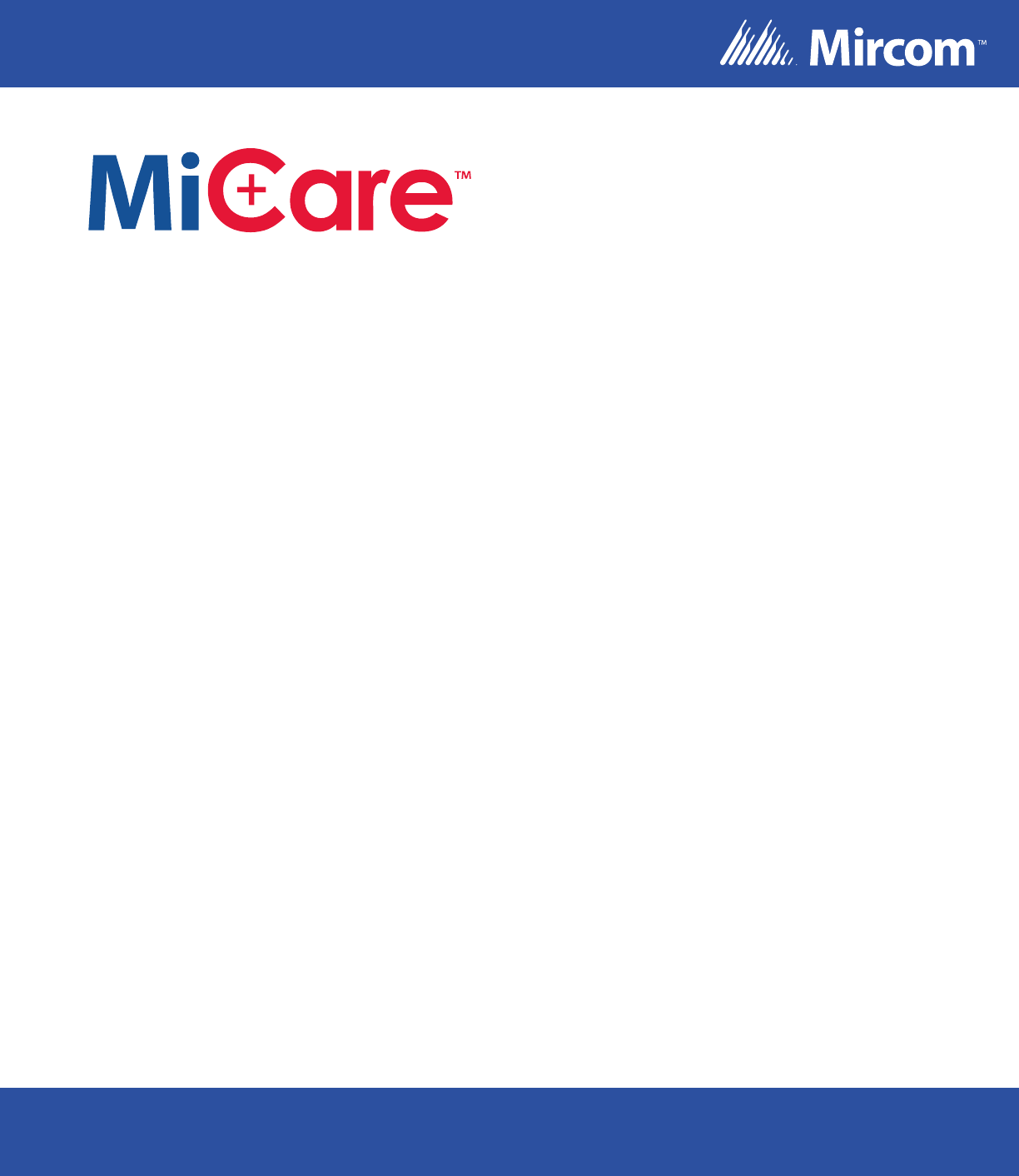
Nurse Call System
LT-2076 Rev. 1.2
September 2015
User Guide
For the latest compatability information visit www.mircom.com/deviceguide

LT-2076 Rev 1.2 3
Table of Contents
1.0 Introduction 5
1.1 About this User Guide .................................................................................................... 5
1.2 Contact Us ..................................................................................................................... 6
1.2.1 General Inquiries ............................................................................................................ 6
1.2.2 Customer Service .......................................................................................................... 6
1.2.4 Website .......................................................................................................................... 6
2.0 Dashboard 7
2.1 Campus, Building, Wing, and Floor ............................................................................... 7
2.2 Alerts .............................................................................................................................. 8
2.3 Alerts List ....................................................................................................................... 8
2.3.1 Speaking to the patient .................................................................................................. 8
2.4 Activity ............................................................................................................................ 9
3.0 Manage My Shift 10
3.1 Logging in to Dashboard ................................................................................................ 10
3.2 Starting your Shift .......................................................................................................... 10
3.3 Recording Breaks .......................................................................................................... 10
3.4 Ending your Shift ............................................................................................................ 10
4.0 Patients and Attendants 11
4.1 Patients .......................................................................................................................... 11
4.1.1 Check Ins ....................................................................................................................... 11
4.2 Attendants ...................................................................................................................... 11
5.0 Active Alerts 12
6.0 Warranty and Warning Information 13
6.1 Warning Please Read Carefully ..................................................................................... 13
6.2 Note to Installers ............................................................................................................ 13
6.3 System Failures ............................................................................................................. 13
6.3.1 Inadequate Installation ................................................................................................... 13
6.3.2 Power Failure ................................................................................................................. 13
6.3.3 Failure of Replaceable Batteries .................................................................................... 13
6.3.4 Compromise of Radio Frequency (Wireless) Devices ................................................... 14
6.3.5 System Users ................................................................................................................. 14

4LT-2076 Rev 1.2
6.3.6 Automatic Alarm Initiating Devices ................................................................................. 14
6.3.7 Software ......................................................................................................................... 14
6.3.8 Alarm Notification ........................................................................................................... 14
6.3.9 Telephone Lines ............................................................................................................. 14
6.3.10 Insufficient Time ............................................................................................................. 15
6.3.11 Component Failure ......................................................................................................... 15
6.3.12 Inadequate Testing ........................................................................................................ 15
6.3.13 Security and Insurance .................................................................................................. 15
6.4 Limited Warranty ............................................................................................................ 15
6.4.1 International Warranty .................................................................................................... 15
6.4.2 Conditions to Void Warranty .......................................................................................... 15
6.5 Warranty Procedure ....................................................................................................... 16
6.6 Disclaimer of Warranties ................................................................................................ 16
6.7 Out of Warranty Repairs ................................................................................................ 16
7.0 Special Notices 18
7.1 Industry Canada Notice .................................................................................................. 18
7.2 FCC Notice ..................................................................................................................... 18

LT-2076 Rev 1.2 5
1.0 Introduction
1.1 About this User Guide
This user guide describes how attendants use the Dashboard Nursing Station
software (Dashboard). With Dashboard, attendants can manage their shifts,
get information about patients, find other attendants, check alerts, and more.
This user guide covers the following models:
•NC-2000 Patient Unit
•NC-500 Pendant
•NC-103 Pull Station
•NC-210 Beacon
•NC-220 ZF3
This user guide covers the following sections of the site:
•Dashboard
•Manage My Shift
•Patients and Attendants
•Active Alerts
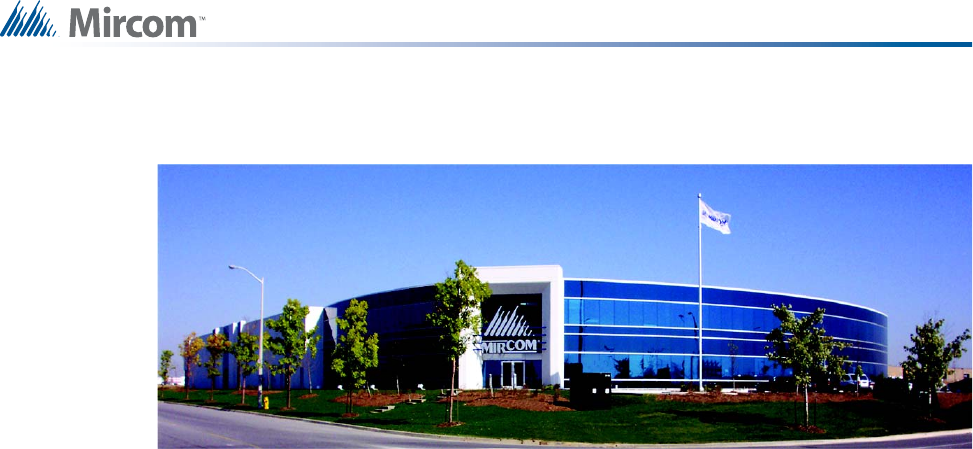
6LT-2076 Rev 1.2
Introduction
1.2 Contact Us
For General Inquiries, Customer Service and Technical Support you can contact us Monday to
Friday 8:00 A.M. to 5:00 P.M. E.S.T.
1.2.1 General Inquiries
Toll Free 1-888-660-4655 (North America Only)
Local 905-660-4655
Email mail@mircom.com
1.2.2 Customer Service
Toll Free 1-888-MIRCOM5 (North America Only)
Local 905-695-3535
Toll Free Fax 1-888-660-4113 (North America Only)
Local Fax 905-660-4113
Email salessupport@mircom.com
1.2.3 Technical Support
Toll Free 1-888-MIRCOM5 (North America Only)
888-647-2665
International 905-647-2665
Email techsupport@mircom.com
1.2.4 Website
www.mircom.com
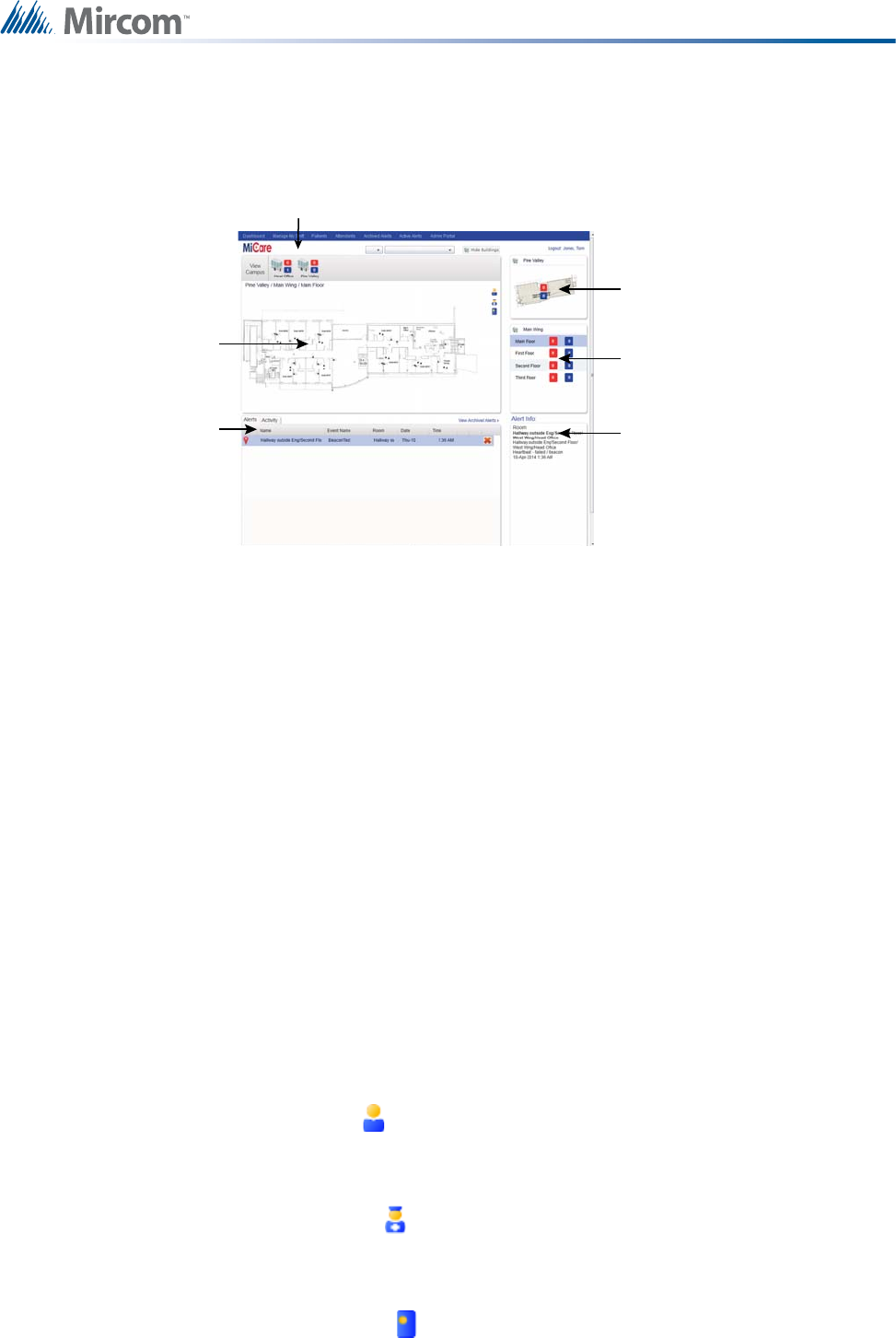
LT-2076 Rev 1.2 7
2.0 Dashboard
In the Dashboard section of the site, you can see active alerts and activity.
Figure 1 Dashboard
2.1 Campus, Building, Wing, and Floor
A campus is a group of buildings that is managed by the MiCare system.
A building is divided into wings, and wings are divided into floors. Floors are referred to by
their campus, wing and floor names, for instance Head Office / West Wing / Second Floor.
To see a building
• Click the building in the Building List.
To see a wing
• Click the wing in the Wing View.
To see a floor
• Click the floor in the Floor View.
To see the patients on a floor
• Click the Patient icon.
To see the attendants on a floor
• Click the Attendant icon.
To see the equipment on a floor
• Click the Equipment icon.
Building List
Map
Alerts List
Wing View
Floor View
Alert Info
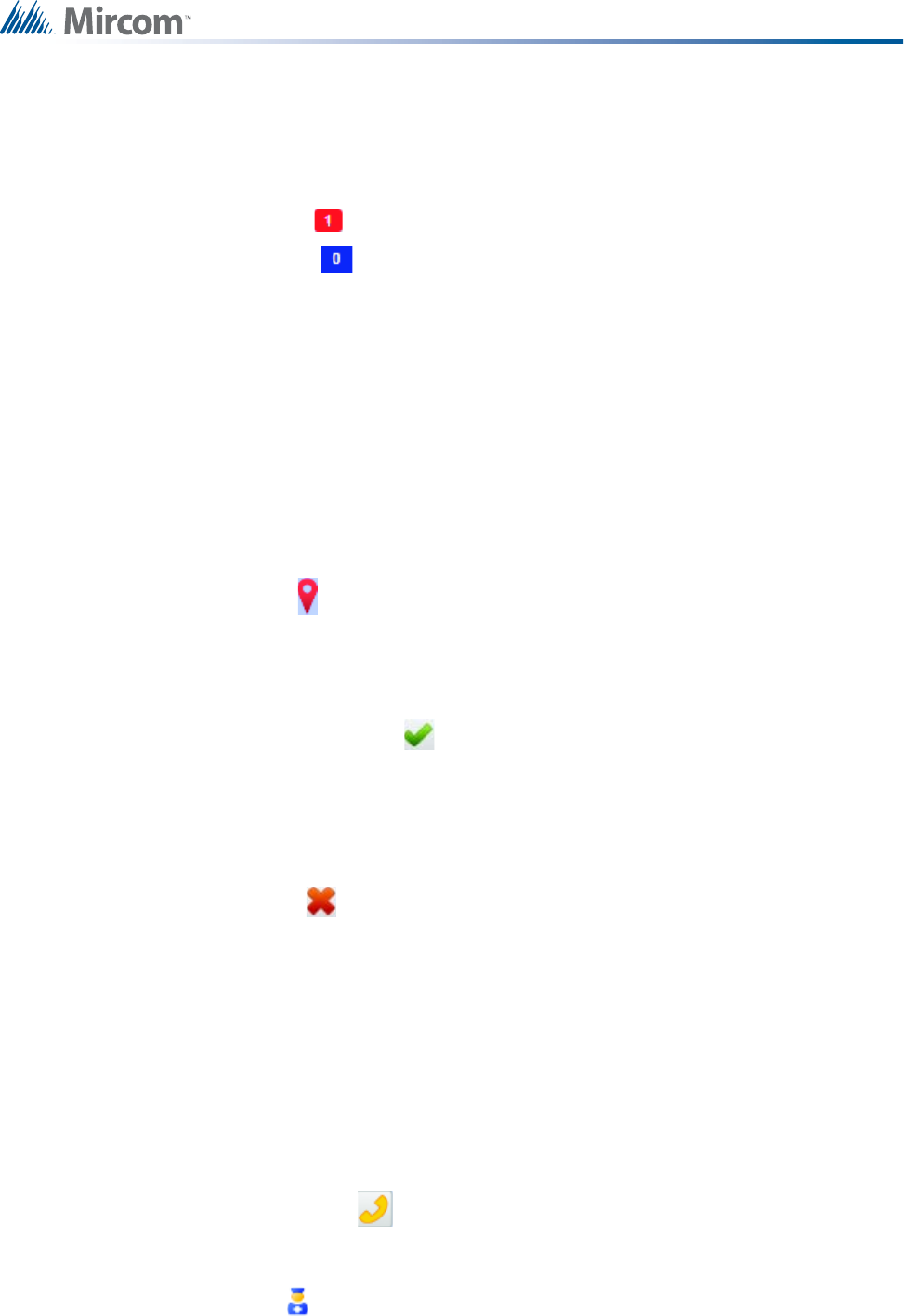
8LT-2076 Rev 1.2
Dashboard
2.2 Alerts
Icons beside each building indicate the alerts in that building.
• Numbers in red indicate emergency alerts.
• Numbers in blue indicate maintenance alerts.
2.3 Alerts List
Alerts appear in the Alerts List.
To see alert information
• Click the alert in the Alerts List.
The Alert Info area shows the location, the cause, and the time of the alert.
To see the location of an alert
• Click the icon to the left of the alert in the Alerts List.
The location of the alert appears in the Map area.
To acknowledge an alert
1. Click the green checkmark in the Alerts List.
2. If you are not logged in, enter your PIN.
When you acknowledge an alert, it is cancelled.
To decline an alert
1. Click the red X in the Alerts List.
2. If you are not logged in, enter your PIN.
When you decline an alert, it is escalated according to the rules defined by the system
administrator.
2.3.1 Speaking to the patient
A phone icon in the Alerts List means that the device sending the alert can function as a
phone.
To speak to the patient
• Click the phone icon.
The device calls your phone number. You can now talk to the patient on your phone.
An Attendant icon in the second column means that an attendant is in the room. In this
case, the phone icon does not appear.

LT-2076 Rev 1.2 9
Dashboard
2.4 Activity
In addition to sending alerts to Dashboard, a device can perform other actions such as
sending a message to an email address, a pager, or a phone number. These actions appear in
the Activity tab in the Alerts List. The Activity tab lists the device’s name, its room, the date
and time it performed the action, and the output and level.
Output: This indicates the kind of action the device performed. Outputs can be the following:
•Call: The device phones an individual or group.
•Email: The device sends an email to an individual or group.
•Pager: The device pages an individual or group.
•SMS: The device sends a text message to an individual or group.
•XML: The device sends an XML message to a device that accepts XML messages.
Level: This indicates the escalation level of the message.

10 LT-2076 Rev 1.2
3.0 Manage My Shift
In the Manage My Shift section of the site, you manage all aspects related to your shifts (for
example, the start of your shift, the end of your shift, and breaks). You must log in at the start
of your shift and log off at the end of your shift.
3.1 Logging in to Dashboard
To log in
1. Click Manage my Shift.
2. Type your PIN in the PIN field, and then click Login.
You were given a PIN by the administrator.
3.2 Starting your Shift
To start your shift
1. If the Phone field is blank, type a telephone number where you can be reached (for
example a cell phone number or extension).
2. If the Pager field is blank, type a pager number if you have one.
3. Click Start Shift.
3.3 Recording Breaks
To record a break
• Click On Break.
• When you return from break, click Back from Break.
3.4 Ending your Shift
To end your shift
• Click End Shift.

LT-2076 Rev 1.2 11
4.0 Patients and Attendants
4.1 Patients
The Patients section lists all the patients in the campus.
To view information about a patient
• Click View Profile.
4.1.1 Check Ins
Check Ins are days and times that the patient is required to check in to Dashboard. If a Check
In is specified, then the patient must activate the associated device once during the time
period. If the device is not activated, then an alert is sent. For example, if the Check In is 10
hours, then the patient must press the button on the device every 10 hours, otherwise the
device sends an alert.
4.2 Attendants
The Attendants section lists all the attendants in the campus.
The Status column indicates whether the attendant is on shift (Active) or not.
The Email and Phone column shows the attendant’s email address and phone number.
Devices use this information to send email, SMS, and phone messages.
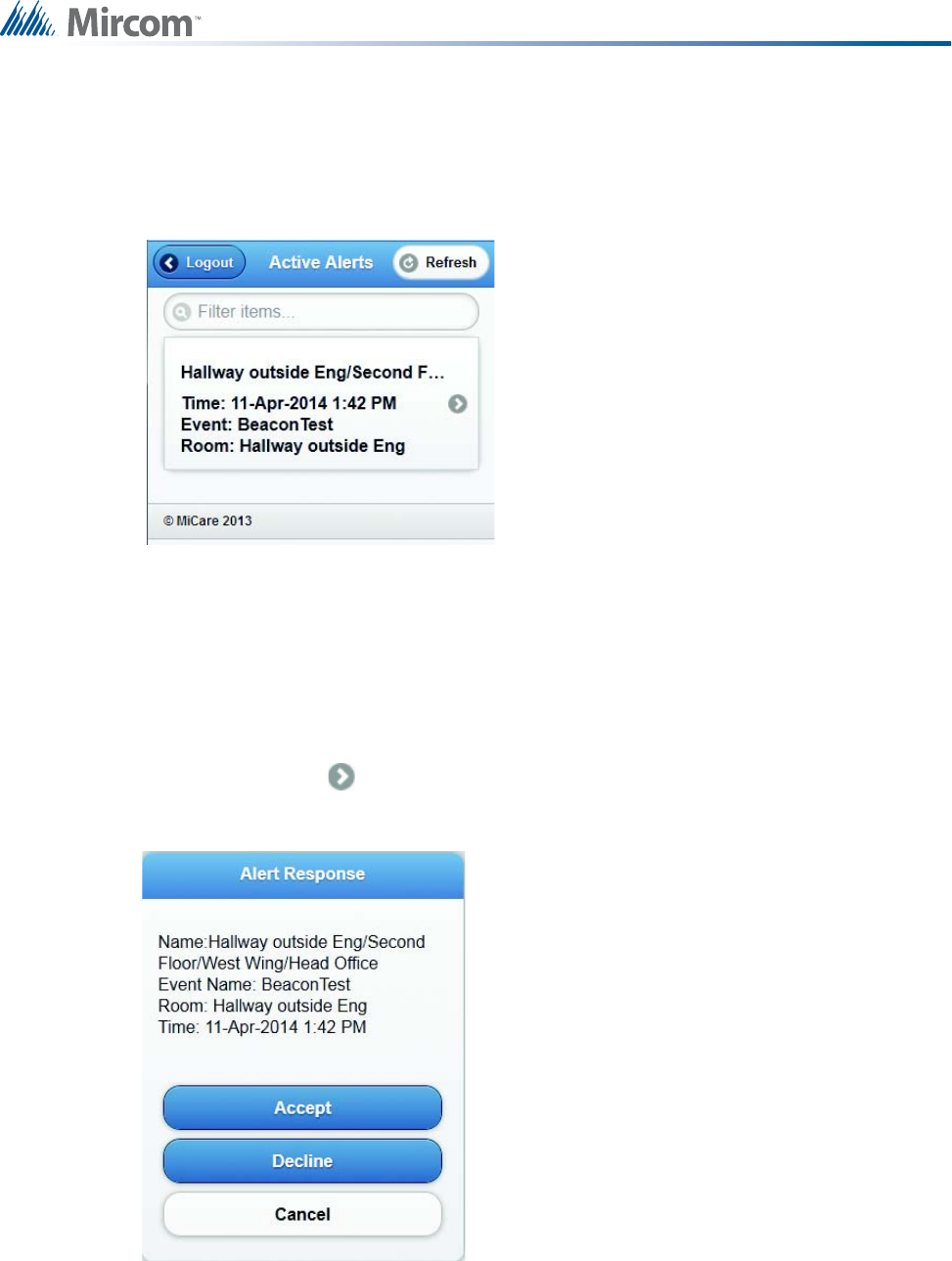
12 LT-2076 Rev 1.2
5.0 Active Alerts
The Active Alerts section shows the same information as appears in the Alerts List (see 2.3
Alerts List on page 8). It is designed to be viewed on a mobile device, such as a phone.
Figure 2 Active Alerts
To search for an alert in a certain building, wing, or room
• Type a building, wing or room in the Filter Items field.
To acknowledge or decline an alert
1. Click the arrow next to the alert.
2. Click the Accept button or the Decline button.
Figure 3 Alert Response
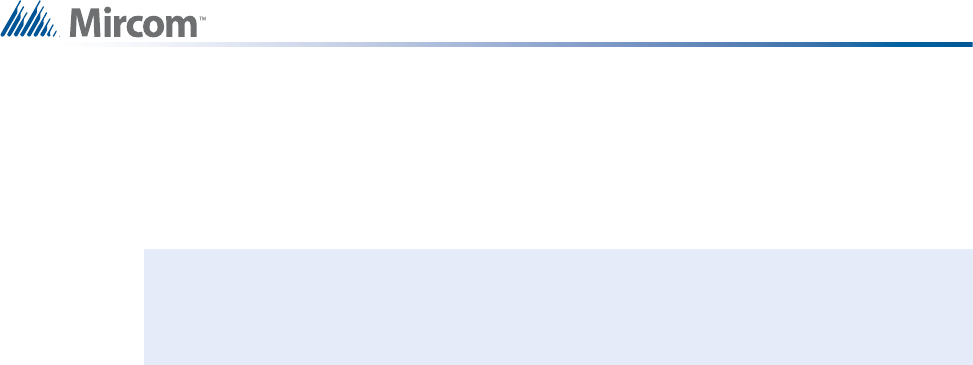
LT-2076 Rev 1.2 13
6.0 Warranty and Warning Information
6.1 Warning Please Read Carefully
6.2 Note to Installers
This warning contains vital information. As the only individual in contact with system users, it is
your responsibility to bring each item in this warning to the attention of the users of this
system. Failure to properly inform system end-users of the circumstances in which the system
might fail may result in over-reliance upon the system. As a result, it is imperative that you
properly inform each customer for whom you install the system of the possible forms of failure.
6.3 System Failures
This system has been carefully designed to be as effective as possible. There are
circumstances, such as fire or other types of emergencies where it may not provide protection.
Alarm systems of any type may be compromised deliberately or may fail to operate as
expected for a variety of reasons. Some reasons for system failure include:
6.3.1 Inadequate Installation
A Nurse Call system must be installed in accordance with all the applicable codes and
standards in order to provide adequate protection. An inspection and approval of the initial
installation, or, after any changes to the system, must be conducted by the Local Authority
Having Jurisdiction. Such inspections ensure installation has been carried out properly.
6.3.2 Power Failure
Patient Units, Beacons, and many other connected devices require an adequate power supply
for proper operation. If the system or any device connected to the system operates from
batteries, it is possible for the batteries to fail. Even if the batteries have not failed, they must
be fully charged, in good condition and installed correctly. If a device operates only by AC
power, any interruption, however brief, will render that device inoperative while it does not
have power. Power interruptions of any length are often accompanied by voltage fluctuations
which may damage electronic equipment such as a nurse call system. After a power
interruption has occurred, immediately conduct a complete system test to ensure that the
system operates as intended.
6.3.3 Failure of Replaceable Batteries
Systems with wireless transmitters have been designed to provide several years of battery life
under normal conditions. The expected battery life is a function of the device environment,
usage and type. Ambient conditions such as high humidity, high or low temperatures, or large
temperature fluctuations may reduce the expected battery life. While each transmitting device
has a low battery monitor which identifies when the batteries need to be replaced, this monitor
Note to End UsersThis equipment is subject to terms and conditions of sale as follows:
i

14 LT-2076 Rev 1.2
Warranty and Warning Information
may fail to operate as expected. Regular testing and maintenance will keep the system in
good operating condition.
6.3.4 Compromise of Radio Frequency (Wireless) Devices
Signals may not reach the receiver under all circumstances which could include metal, water,
or concrete objects placed on or near the radio path or deliberate jamming or other inadvertent
radio signal interference.
6.3.5 System Users
A user may not be able to operate a panic or emergency switch possibly due to permanent or
temporary physical disability, inability to reach the device in time, or unfamiliarity with the
correct operation. It is important that all system users be trained in the correct operation of the
nurse call system and that they know how to respond when the system indicates an alarm.
6.3.6 Automatic Alarm Initiating Devices
Motion sensors, smoke detectors, heat detectors and other alarm initiating devices that may
be an ancillary part of this system may not properly detect an alarm condition or signal the
Central controller to alert occupants of an alarm condition for a number of reasons, such as:
the motion sensor, smoke detectors or heat detector may have been improperly installed or
positioned; smoke or heat may not be able to reach the alarm initiating device, such as when
the fire is in a chimney, walls or roofs, or on the other side of closed doors; and, smoke and
heat detectors may not detect smoke or heat from fires on another level of the residence or
building. Motion sensors must be kept clear of any obstacle to impede the sensors ability to
detect movement.
6.3.7 Software
Most Mircom products contain software. With respect to those products, Mircom does not
warranty that the operation of the software will be uninterrupted or error-free or that the
software will meet any other standard of performance, or that the functions or performance of
the software will meet the user’s requirements. Mircom shall not be liable for any delays,
breakdowns, interruptions, loss, destruction, alteration or other problems in the use of a
product arising our of, or caused by, the software.
6.3.8 Alarm Notification
Alarm Notification such as Dashboard alerts or pocket pager messages may not warn
attendants if they are not in direct proximity. If notification devices are located on a different
level of the residence or premise, then it is less likely that the attendants will be alerted.
Audible notification may be interfered with by other noise sources such as stereos, radios,
televisions, air conditioners or other appliances, or passing traffic. Audible notification,
however loud, may not be heard by a hearing impaired person.
6.3.9 Telephone Lines
If telephone lines are used to transmit alarms, they may be out of service or busy for certain
periods of time. Also the telephone lines may be compromised by such things as criminal
tampering, local construction, storms or earthquakes.

LT-2076 Rev 1.2 15
Warranty and Warning Information
6.3.10 Insufficient Time
There may be circumstances when the system will operate as intended, yet the occupants will
not be protected from the emergency due to their inability to respond to the warnings in a
timely manner. If the system is monitored, the response may not occur in time enough to
protect the occupants or their belongings.
6.3.11 Component Failure
Although every effort has been made to make this system as reliable as possible, the system
may fail to function as intended due to the failure of a component.
6.3.12 Inadequate Testing
Most problems that would prevent an alarm system from operating as intended can be
discovered by regular testing and maintenance. The complete system should be tested as
required by national standards and the Local Authority Having Jurisdiction and immediately
after a fire, storm, earthquake, accident, or any kind of construction activity inside or outside
the premises. The testing should include all sensing devices, keypads, consoles, alarm
indicating devices and any other operational devices that are part of the system.
6.3.13 Security and Insurance
Regardless of its capabilities, an alarm system is not a substitute for property or life insurance.
An alarm system also is not a substitute for property owners, attendants, nursing staff or other
care giver personnel to act prudently to prevent or minimize the harmful effects of an
emergency situation.
IMPORTANT NOTE: End-users of the system must take care to ensure that the system,
batteries, telephone lines, etc. are tested and examined on a regular basis to ensure the
minimization of system failure.
6.4 Limited Warranty
Mircom Technologies Ltd. together with its subsidiaries and affiliates (collectively, the “Mircom
Group of Companies”) warrants the original purchaser that for a period of one year from the
date of shipment, the product shall be free of defects in materials and workmanship under
normal use. During the warranty period, Mircom shall, at its option, repair or replace any
defective product upon return of the product to its factory, at no charge for labor and materials.
Any replacement and/or repaired parts are warranted for the remainder of the original warranty
or ninety (90) days, whichever is longer. The original owner must promptly notify Mircom in
writing that there is defect in material or workmanship, such written notice to be received in all
events prior to expiration of the warranty period.
6.4.1 International Warranty
The warranty for international customers is the same as for any customer within Canada and
the United States, with the exception that Mircom shall not be responsible for any customs
fees, taxes, or VAT that may be due.
6.4.2 Conditions to Void Warranty
This warranty applies only to defects in parts and workmanship relating to normal use. It does
not cover:

16 LT-2076 Rev 1.2
Warranty and Warning Information
• damage incurred in shipping or handling;
• damage caused by disaster such as fire, flood, wind, earthquake or lightning;
• damage due to causes beyond the control of Mircom such as excessive voltage,
mechanical shock or water damage;
• damage caused by unauthorized attachment, alterations, modifications or foreign
objects;
• damage caused by peripherals (unless such peripherals were supplied by Mircom);
• defects caused by failure to provide a suitable installation environment for the products;
• damage caused by use of the products for purposes other than those for which it was
designed;
• damage from improper maintenance;
• damage arising out of any other abuse, mishandling or improper application of the
products.
6.5 Warranty Procedure
To obtain service under this warranty, please return the item(s) in question to the point of
purchase. All authorized distributors and dealers have a warranty program. Anyone returning
goods to Mircom must first obtain an authorization number. Mircom will not accept any
shipment whatsoever for which prior authorization has not been obtained. NOTE: Unless
specific pre-authorization in writing is obtained from Mircom management, no credits will be
issued for custom fabricated products or parts or for complete fire alarm system. Mircom will at
its sole option, repair or replace parts under warranty. Advance replacements for such items
must be purchased.
Note: Mircom’s liability for failure to repair the product under this warranty after a reasonable
number of attempts will be limited to a replacement of the product, as the exclusive remedy for
breach of warranty.
6.6 Disclaimer of Warranties
This warranty contains the entire warranty and shall be in lieu of any and all other warranties,
whether expressed or implied (including all implied warranties of merchantability or fitness for
a particular purpose) And of all other obligations or liabilities on the part of Mircom neither
assumes nor authorizes any other person purporting to act on its behalf to modify or to change
this warranty, nor to assume for it any other warranty or liability concerning this product.
This disclaimer of warranties and limited warranty are governed by the laws of the province of
Ontario, Canada.
6.7 Out of Warranty Repairs
Mircom will at its option repair or replace out-of-warranty products which are returned to its
factory according to the following conditions. Anyone returning goods to Mircom must first
obtain an authorization number. Mircom will not accept any shipment whatsoever for which
prior authorization has not been obtained.
Products which Mircom determines to be repairable will be repaired and returned. A set fee
which Mircom has predetermined and which may be revised from time to time, will be charged
for each unit repaired.
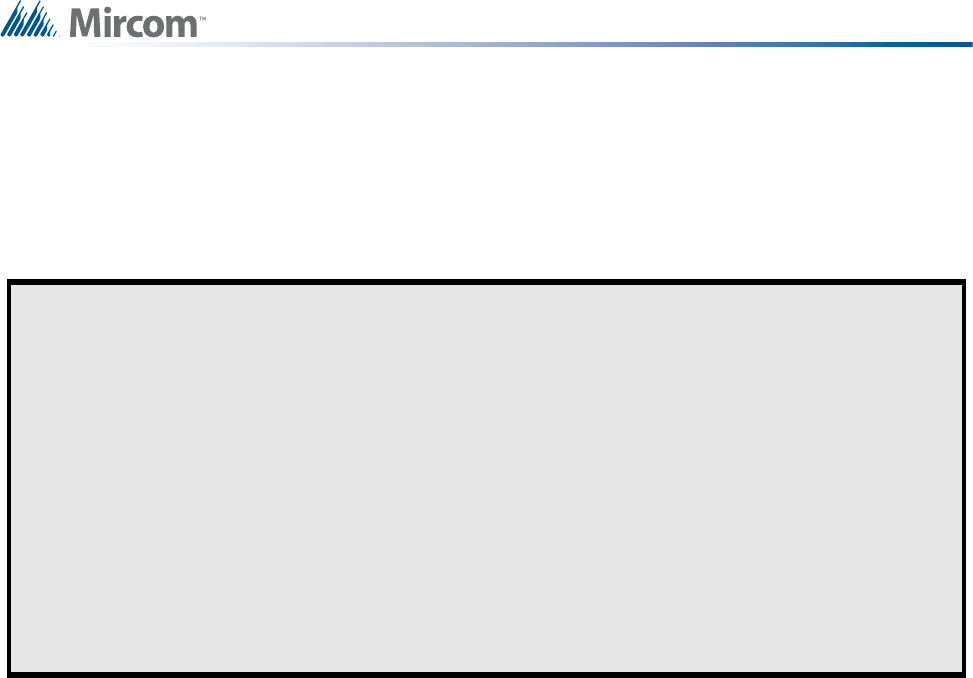
LT-2076 Rev 1.2 17
Warranty and Warning Information
Products which Mircom determines not to be repairable will be replaced by the nearest
equivalent product available at that time. The current market price of the replacement product
will be charged for each replacement unit.
The preceding information is accurate as of the date of publishing and is subject to change or revision
without prior notice at the sole discretion of the Company.
WARNING: Mircom recommends that the entire system be completely tested on a regular basis.
However, despite frequent testing, and due to, but not limited to, criminal tampering or electrical
disruption, it is possible for this product to fail to perform as expected.
NOTE: Under no circumstances shall Mircom be liable for any special, incidental, or consequential
damages based upon breach of warranty, breach of contract, negligence, strict liability, or any
other legal theory. Such damages include, but are not limited to, loss of profits, loss of the product
or any associated equipment, cost of capital, cost of substitute or replacement equipment,
facilities or services, down time, purchaser’s time, the claims of third parties, including
customers, and injury to property.
MIRCOM MAKES NO WARRANTY OF MERCHANTABILITY OR FITNESS FOR A PARTICULAR
PURPOSE WITH RESPECT TO ITS GOODS DELIVERED, NOR IS THERE ANY OTHER WARRANTY,
EXPRESSED OR IMPLIED, EXCEPT FOR THE WARRANTY CONTAINED HEREIN.

18 LT-2076 Rev 1.2
7.0 Special Notices
7.1 Industry Canada Notice
This device complies with Industry Canada’s license-exempt RSSs. Operation is subject to the
following two conditions:
(1) This device may not cause interference; and
(2) This device must accept any interference, including interference that may cause undesired
operation of the device.
Cet appareil est conforme aux CNR sans licenses requises d'Industrie Canada. Son
fonctionnement est soumis aux deux conditions suivantes :
( 1 ) Ce dispositif ne peut produire des interférences ; et
( 2 ) Ce dispositif doit accepter toute interférence, y compris les interférences qui peuvent
entraîner un mauvais fonctionnement de l'appareil.
7.2 FCC Notice
This device complies with Part 15 of the FCC Rules. Operation is subject to the following two
conditions: (1) this device may not cause harmful interference, and (2) this device must accept
any interference received, including interference that may cause undesired operation.

CANADA - Main Office
25 Interchange Way
Vaughan, ON L4K 5W3
Tel: (888) 660-4655
(905) 660-4655
Fax: (905) 660-4113
© Mircom 2015
Printed in Canada
Subject to change without prior notice
www.mircom.com
U.S.A
4575 Witmer Industrial Estates
Niagara Falls, NY 14305
Tel: (888) 660-4655
Fax: (888) 660-4113
TECHNICAL SUPPORT
North America
Tel: (888) Mircom5
(888) 647-2665
International
Tel: (905) 660-4655